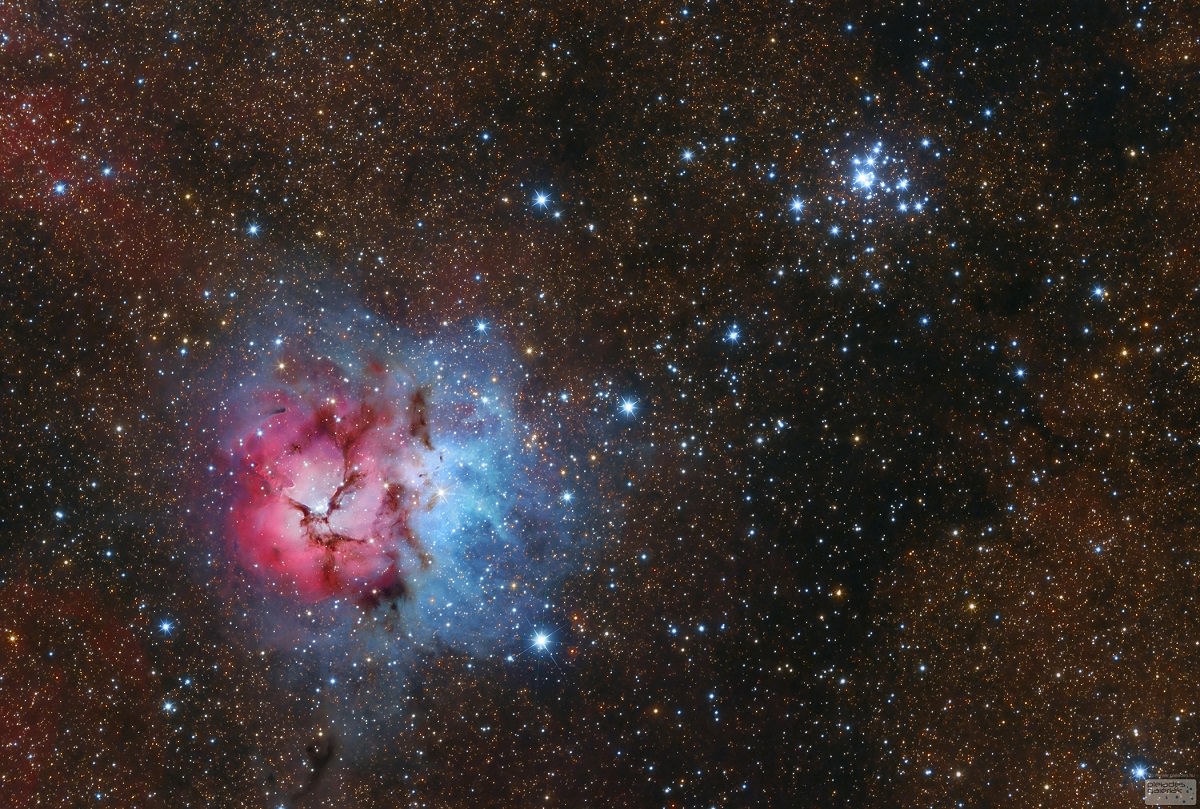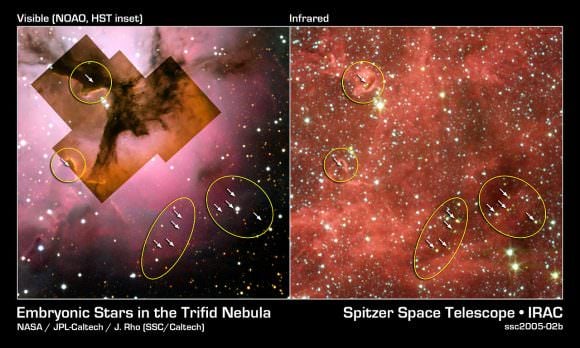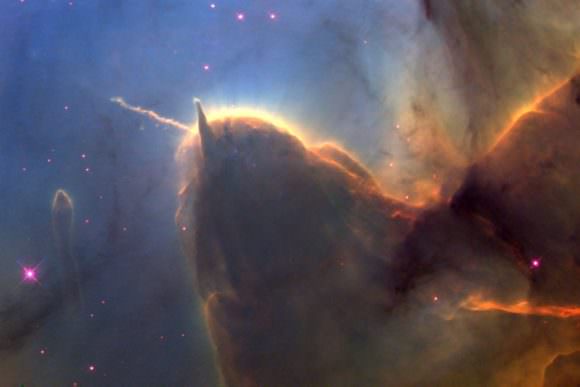Welcome back to Messier Monday! In our ongoing tribute to the great Tammy Plotner, we take a look at the Trifid Nebula (aka. Messier 20). Enjoy!
Back in the 18th century, famed French astronomer Charles Messier noted the presence of several "nebulous objects" in the night sky. Having originally mistaken them for comets, he began compiling a list of these objects so that others wouldn't make the same mistake. Consisting of 100 objects, the
Messier Catalog
would come to be viewed by posterity as a major milestone in the study of Deep Space Objects.
One of these objects is the Trifid Nebula (aka. Messier 20, NGC 6514), a star-forming region of ionized gas located in the
Scutum spiral arm
of the Milky Way, in the direction of the southern
Sagittarius
constellation. A bright object that is a favorite amongst amateur astronomers, this object is so-named because it is a combination open star cluster, emissions nebula, reflection nebula, and a dark nebula that looks like it consists of three lobes.
Description:
Almost everyone who is familiar with space images has likely seen a beautiful color image of this emission and reflection nebula. However, when looking at M20 through a telescope, what you will see will be less colorful. Why? When it comes to photographs, exposure times and wavelengths cause different colors to become visible.
[caption id="attachment_130027" align="aligncenter" width="580"]
Composite image comparing visible-light views from Hubble of the Trifid Nebula with an infrared view from NASA's Spitzer Space Telescope of the glowing Trifid Nebula. Credit: NASA/JPL-Caltech/J. Rho (SSC/Caltech)
[/caption]
Photographically, the red emission nebula contained within Messier 20 has a bright blue star cluster in it central portion. It glows red because the ultraviolet light of the stars ionizes the hydrogen gas, which then recombines and emits the characteristic red hydrogen-alpha light captured on film. Further away, the radiation from these hot, young stars becomes too weak to ionize the hydrogen. Now the gas and dust glows blue by reflection!
No matter how it is observed, the Trifid - or "three lobed" - nebula has a distinctive set of dark dust lanes which divide it. These also have a classification of their own, and were cataloged by E.E. Barnard as a dark nebula -
Barnard 85
(B 85). In 1999 the Hubble Space Telescope took a look deep into the Trifid nebula at some of its star forming regions (see below).
What it found was a stellar jet poking its way into the cloud, like a fabulous twisted antenna. Inside the exhaust column is a new star waiting to be born, yet sometime over the next 10,000 years the central massive star will probably erode away all of its material before it can fully form. Nearby, a stalk stands waiting.
[caption id="attachment_130030" align="aligncenter" width="580"]
Close up on the interior of the Trifid Nebula, showing the star forming region and a stellar jet. Credit: NASA/HST
[/caption]
Like the jet, it is also a stellar nursery - one with an EGG (evaporating gaseous globule) at its tip - a condensed cloud of gas able to survive so far. As Jeff Hester of the Department of Physics & Astronomy explained:
We know that Messier 20 contains new stars, but what about old stars? Are there surprises buried within these bright folds that still await discovery? According to F. Yusef-Zadeh (et al) and a 2000 study titled "
Radio continuum emission from the central stars of M20 and the detection of a new supernova remnant near M20
", the answer is yes:
[caption id="attachment_130029" align="aligncenter" width="580"]
The Trifid nebula (M20, NGC NGC 6514) in pseudocolor. Image taken with the Palomar 1.5-m telescope. Credit: Jeff Hester (Arizona State University)/Palomar telescope
[/caption]
History of Observation:
Charles Messier discovered this object on June 5th, 1764. As he recorded of the object in his notes:
While Messier did separate the two star clusters, he did not note so many different portions to the nebula - but, he did note nebulosity. In this circumstance, we cannot fault him. His purpose was to locate comets, after all; and the reason for the catalog was to list objects that were not. In later years, it would be Sir William Herschel who would take a closer look at Messier 20 and discover much more. As he wrote of the nebula:
[caption id="attachment_130028" align="aligncenter" width="580"]
A close detail of the Trifid Nebula, showing a "Pillar" region. Credit: NASA/Jeff Hester (Arizona State University).
[/caption]
While William went on to catalog four separate areas in his books, it was his son John to whom we owe the famous name that we know it by today. "A most remarkable object. Very large; trifid, three nebulae with a vacuity in the midst, in which is centrally situated the double star Sh 379, the nebula is 7' in extent. A most remarkable object."
Just remember when you observe that sky conditions are everything and that not even a large telescope can make it appear if the sky isn't right. Even Admiral Smyth has his share of troubles spotting it. Said he of the Trifid Nebula:
Locating Messier 20:
Once you have become familiar with the Sagittarius region, finding Messier 20 is easy, since it is located just 2 degrees northwest of
Messier 8
- the "Lagoon" Nebula. However, at magnitude 9, it isn't an easy to spot with small binoculars, and not always easy for a small telescope either. Because we often see it depicted in pictures as bright and beautiful, we simply assume M20 will jump out of the sky; but you'll find that its a lot fainter and more elusive than you might think.
[caption id="attachment_123651" align="aligncenter" width="459"]
The Sagittarius constellation. Credit: iau.org
[/caption]
If you are a beginner to astronomy, try starting at the teapot's tip star (Lambda), "Al Nasl", and starhopping in the finderscope northwest to the Lagoon. While the nebulosity might not show in your finder, the optical double star 7 Sagittari, will. From there you will spot a bright cluster of stars two degrees due north. These are the stars embedded withing the Trifid and the small, compressed area of stars to its northeast is the open star cluster of
Messier 21
.
Center your finderscope on the north and south oriented pair of stars and observe. Remember that you will need a moonless night and that sky conditions will need to be right to see the dark dustlanes! And here are the quick facts about M20, for your convenience:
- Object Name
-
Messier 20
- Alternative Designations
-
M20, NGC 6514, Trifid Nebula
- Object Type
-
Emission Nebula and Reflection Nebula with Open Star Cluster
- Constellation
-
Sagittarius
- Right Ascension
-
18 : 02.6 (h:m)
- Declination
-
-23 : 02 (deg:m)
- Distance
-
5.2 (kly)
- Visual Brightness
-
9.0 (mag)
- Apparent Dimension
-
28.0 (arc min)
Good luck and enjoy your observations!
We have written many interesting articles about Messier Objects here at Universe Today. Here's Tammy Plotner's
Introduction to the Messier Objects
, ,
M1 – The Crab Nebula
,
M8 – The Lagoon Nebula
, and David Dickison's articles on the
2013
and
2014
Messier Marathons.
Be to sure to check out our complete
Messier Catalog
. And for more information, check out the
SEDS Messier Database
.
 Universe Today
Universe Today



![The Trifid nebula (M20, NGC NGC 6514) in pseudocolor. Image taken with the Palomar 1.5-m telescope. The field of view is 16’ ´ 16’. Red shows [S II] ll 6717+6731. Green shows Ha l 6563. Blue shows [O III] l 5007. The WFPC2 field of view is indicated. Image: Jeff Hester (Arizona State University), Palomar telescope.](/article_images/Trifid-Nebula-M20-e1469471610624-580x515.jpg)

